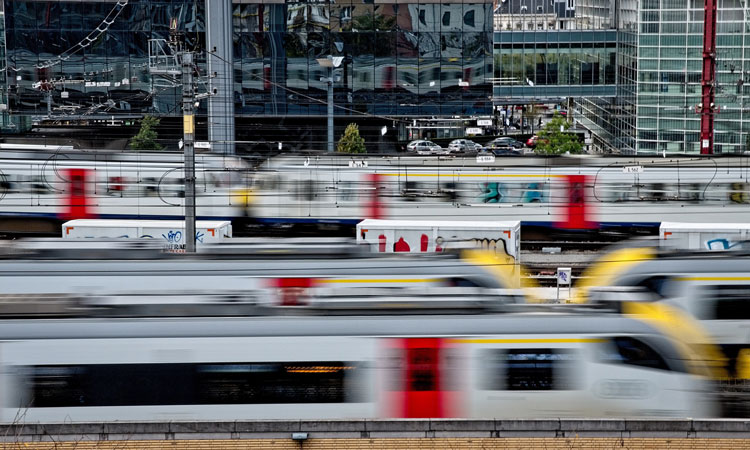Designing tomorrow’s European rail system: The Fourth Railway Package and TSIs for a SERA
Posted: 26 April 2021 | Nicholas Shrimpton | No comments yet
Nicholas Shrimpton, UNIFE’s Technical Affairs Manager, explores the intricacies of the introduction of the Fourth Railway Package’s (4RP) Technical Pillar, and the key elements that will ensure its full and successful adoption going forward.


The European Union (EU) that we enjoy today was just a dream a few short decades ago. A continent once known for its rivalries and myriad of borders has become renowned for its interconnectedness, with it now possible for citizens to work and travel relatively freely across the 27 Member States. However, despite in many ways being long emblematic of the European freedom of movement, there are still technical limitations to the completely seamless interoperability of our railway systems. The Technical Pillar of the Fourth Railway Package (4RP) is a monumental step towards that end. Through a full actualisation of the initiative, Brussels can more swiftly, and at lower costs, implement a truly singular European railway area.
The Technical Pillar, comprised of the re-casted Interoperability and Safety Directives and the ERA Regulation, is of paramount importance for the rail industry’s competitiveness, as it aims to remove the remaining technical barriers to the creation of a Single European Railway Area (SERA). It entered into force on 15 June 2016 and provided Member States with a three-year transposition period. Many Member States elected to trigger the original package’s upon-request one-year extension, then, due to the urgency of the COVID-19 pandemic, the European Commission’s (EC) COVID-19 ‘rail relief package’ pushed the transposition deadline to 31 October 2020. As such, 2020 became a key year for the implementation of 4RP’s Technical Pillar, with the arrival of the final transposition deadlines and the long-awaited entry into operation of the new regime throughout all the European Member States.
UNIFE strongly supported the adoption of the Technical Pillar, as it is integral to the creation of a harmonised European authorisation process ran by the newly fortified European Union Agency for Railways (ERA), under the leadership of its Executive Director, Dr. Josef Doppelbauer, which should result in a convergence and greater certainty of requirements. This development will also result in a more consistent, quicker and cheaper process that produces less duplication of checks and testing processes. In addition, it is also seen as an opportunity for the deployment of the European Rail Traffic Management System (ERTMS) in Europe, as ERA is now the ERTMS System Authority. Since 2016, our association has been heavily involved in the development of the 4RP process, providing a common rail supply industry position – particular focus was directed at the new vehicle authorisation process. Most notably, we have contributed perspectives for the practical arrangements for the railway vehicle authorisation (EU 2018/545), its accompanying guidelines and development of the One-Stop Shop (OSS) IT Tool.
We are now approaching the two-year anniversary since Bulgaria, Finland, France, Greece, Italy, the Netherlands, Romania and Slovenia adopted the 4RP Technical Pillar regime on 16 June 2019. In this time, ERA has delivered over 1,500 vehicle authorisation decisions, resulting in over 17,000 authorised rail vehicles – a commendable feat given their new role. With the Technical Pillar entering into operation in all Member States at the end of 2020, close attention will be paid throughout 2021 in a bid to ensure the realisation and full delivery of the 4RP’s expected and promised benefits.
Ensuring clear knowledge exchange
It is important that the European rail supply industry continues to remain united in its engagement on this issue and proactive in our engagements with EU bodies, such as the EC and ERA, if we are to achieve the 4RP’s Technical Pillar goals in the years to come.
Since the entry into operation, UNIFE is working together with ERA and the National Safety Authorities (NSAs) to help to build upon the collective’s shared initial experiences of the package. Now that the 4RP has been transposed across the entire European Union, UNIFE remains committed to facilitating best practice by ensuring clear knowledge exchange between the European rail supply industry, the European institutions and national governments. This shift in focus, being internally carried out by our UNIFE Standards and Regulation Group (SRG), permits the effective collection of feedback on the new processes in an attempt to ensure that the lessons learnt are shared, issues are resolved and agreements on further enhancements are reached in order to streamline the new system. These efforts have raised awareness and greater understanding of changes within the rail supply industry currently being implemented under this new framework.
It is important that the European rail supply industry continues to remain united in its engagement on this issue and proactive in our engagements with EU bodies, such as the EC and ERA, if we are to achieve the 4RP’s Technical Pillar goals in the years to come. As a permanent member of the EC’s Expert Group on the Technical Pillar of the Fourth Railway Package, a member of the 4RP Steering Group established by the ERA Management Board and within the ERA’s Network of Representative Bodies, UNIFE partakes in regular exchanges on the 4RP, alongside Member States representatives and other official representative bodies. These forums provide vital exchange platforms to facilitate raising concerns pertaining to the package’s implementation, as well as identify and discuss challenges that may arise as stakeholders cooperate to achieve its goals. Concrete problems linked to the daily work of its application are shared openly, helping stakeholders to develop solutions on the basis of different experiences and best practices.
In addition to engagements with official forums, dialogues held directly with ERA and the EC’s DG MOVE has been beneficial. Through discussions between UNIFE and the ERA Planning Approvals & Delivery (PAD) Unit and cooperation with the European rail sector through, notably, the Group of Representative Bodies, the European railway sector has progressed on the working details of vehicle authorisation applications and common feedback towards greater clarity on these important processes and needed stability on the regulatory side. Additionally, our association has established a high-level exchange between DG MOVE’s Directorate C – which is responsible for land transport – and ERA management teams, which has strived to jointly and closely monitor the final implementation activities of the 4RP as it entered operation at ERA in June 2019 and assess its impacts on the business of the European rail supply industry, as well as identify common actions to ensure the smooth transition to the new regime.
Enhancing cooperation and openness
However, despite this collaboration from across the railway ecosystem, the key question remains: when will Europe achieve the 4RP objective of a 20 per cent reduction in both the cost and duration of the rolling stock authorisation procedure? Unfortunately, thus far, the industry has not witnessed such a development since the introduction of the new process. As we have now experienced two years of the current system, it is paramount that European rail actors reflect on the impacts of the 4RP’s Technical Pillar and the ways in which it can be streamlined to limit bureaucratic obstacles and eliminate unnecessary costs, as originally intended.
For starters, it would be advisable for the aforementioned forums to enhance their cooperation and openness towards simplifying the new vehicle authorisation processes and requirements, furthering development and interoperability between the related ERA IT tools, deepening their reviews of the transposition by Member States and ensuring that a harmonised process is delivered in practice. Additionally, these bodies are well-suited to finalising the long-overdue clean-up programme for the Notified National Technical Rules for vehicle authorisation, which remains a key cost driver in today’s vehicle authorisation process and increasing the competitiveness of the railway sector with the upcoming TSI amendments. ERA and DG MOVE’s openness to agreeing on practical measures intended to facilitate the authorisation applications and process will be a deciding factor in its success. Flexibility is needed to allow updates and alterations in the standing legal framework where technical barriers or administrative burden remains.
Concerningly, the ERA was recently subjected to a budget cut, which hampers Europe’s ability to enjoy the full benefits of the Technical Pillar and limits the agency’s ability to dedicate resources to improve the process itself. Given the European Union’s designation of 2021 as the ‘European Year of Rail’, and in view of the railway’s vital role played in achieving the EU Green Deal goal of decarbonising our transport sector, it is all the more regrettable that the ERA is the only transport-related executive agency to experience this form of budget reduction. UNIFE calls on the EC to significantly increase ERA’s budget in 2022.
The Technical Pillar of the 4RP is an essential step towards a SERA and the swift mobilisation of the next generation vehicles needed to operate it.
Despite this setback, the sector continues to work towards the development and application of Technical Specifications for Interoperability (TSIs) on the European railway target system and, more specifically, the necessary transitional provisions required to provide the rail supply industry with stability for individual railway projects while the regulations, standards and innovations continue to evolve. This subject is considered a priority for the planning and competitiveness of long-term rail projects and delivery of vehicle types, in connection with the 4RP objectives. This topic will be addressed by amendments to the TSI transitional provisions in the 2022 TSI package. UNIFE has recently published a Position Paper on ‘TSI Transitions for a Competitive European Railway Sector’. With this paper, UNIFE aims to raise the awareness of all sector stakeholders, European institutions and Member States to the potential risks associated with the current proposals made by ERA reviewing the TSI’s transitional provisions. These results will have a significant impact on the railway sector over the next decade: it is essential that the to-be-established transition regime ensures stability, predictability and transparency for businesses.
Seize opportunities
UNIFE calls on the EC, ERA and Member States to take the opportunity presented by the 2022 TSI revision to simplify the TSI transitional provisions to improve the competitiveness of the European railway sector and its supply industry. It is essential that the sector benefits from today’s TSI maturity – especially regarding interoperability, safety and from market-driven product innovations. UNIFE considers the increased stability and predictability of the European technical framework and TSI transitions as a priority for the European rail supply industry.
The Technical Pillar of the 4RP is an essential step towards a SERA and the swift mobilisation of the next generation vehicles needed to operate it. Ensuring its swift implementation and timely recalibrations of its processes and tools, together with the ongoing TSIs revision, is critical for its success through delivery of its expected reductions in cost and time, as well as a stable, predictable and transparent rail transport sector. Moreover, it is of paramount importance to include in the 2022 CCS TSI revision the work performed currently within the Shift2Rail Joint Undertaking (S2R JU) on the ERTMS Game Changers. The involvement of ERA in S2R JU and its successor, Europe’s Rail Joint Undertaking (ERJU) within Horizon Europe, is key for speeding up the digitalisation of European rail transport. This will be reinforced by the running of the future ERJU’s ‘System Pillar’, responsible notably for the delivery of a harmonised European rail CCS system architecture, which shall improve the efficiency and performance of rail transport in the next decade.
Working together, and with commitment of the necessary resources, European institutions, Member States and railway stakeholders can put Europe on track to a decade punctuated by thriving rail fit for a green tomorrow.


Related topics
Related organisations
European Commission (EC), European Union Agency for Railways (ERA), Europe’s Rail Joint Undertaking (EU-Rail), UNIFE (the European Rail Supply Industry)








